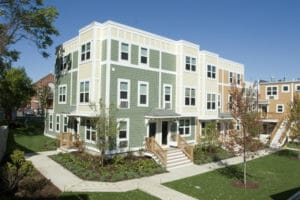Top Story
Chelsea’s Box District Demonstrates the Power of High-Quality Affordable Housing to Attract Market-Rate Development
June 28, 2016
The push to redevelop a series of former mattress and cardboard-box factories into what became known as the Box District—a mixed-income neighborhood in Chelsea, Massachusetts, just north of Boston—came from a nonprofit housing developer that began developing affordable housing there in 1979. The Neighborhood Developers (TND) has always sought to create better housing options for this working-class city with a faded industrial past that is now home to a large population of Latin American immigrants and foreign-born residents.
In 2005, when TND and the city of Chelsea sought out partners to create a mixed-income neighborhood on the 10.5-acre (4.25 ha) site, few private developers showed interest. Once the heart of Chelsea’s industrial economy, the neighborhood was blighted, lacked streetlights and sidewalks, and was perceived as a high-crime area. Private developers “couldn’t see the vision or access the financing” to develop market-rate housing on the site, said Emily Loomis, TND’s director of real estate development, during a recent tour of the Box District for ULI members. The lack of comparable market-rate product in adjacent neighborhoods made it difficult to persuade market-rate developers to invest, she said.
The global recession certainly did not help, yet TND persevered and debuted two new developments—Janus Highlands, a 100 percent affordable project composed of 41 one- to four-bedroom apartments, and Box Works Homes, 26 townhomes featuring a mix of market-rate and workforce housing—in 2008. The projects, which cost TND nearly $20 million to develop, were worth the effort because shortly thereafter, Mitchell Properties, a developer of mixed-use projects founded by Bart Mitchell, committed to the vision of the Box District as a truly mixed-income neighborhood.
“The affordable housing was built first, and actually made it more favorable to market-rate development,” Loomis said. TND’s consistent presence in Chelsea “set the table for what we as a private developer could do,” said Dave Traggorth, former project manager of Mitchell Properties who spun off his own firm, Traggorth Companies, in 2012. Mitchell Properties completed its first Box District project—a conversion of a 19th-century mill into the 53-unit Atlas Lofts—in 2010; and later that year, another private developer, D’Amico Rental Property, built a dozen market-rate apartments in three properties.
The Box District shows that “high-quality affordable housing can attract market-rate housing,” Traggorth said, a necessary component of mixed-income neighborhoods. What also gave market-rate developers an incentive to develop in untested markets was the state government’s investment in Chelsea and other “gateway cities”—former industrial cities with high unemployment rates and lower-than-average household median incomes—throughout Massachusetts. Using a state tax credit program targeted to gateway cities, Traggorth Companies built Flats@44, a 46-unit mix of market-rate studios and one- and two-bedroom units, built off site through modular construction. And last year, Flats@22, a mixed-income apartment building with 29 market-rate and 21 affordable units, was completed using low-income housing tax credits.

The Box District Park attracts kids from the neighborhood. (photo courtesy of The Neighborhood Developers)
Because of its proximity to Boston and new transportation investments in the area, Chelsea is becoming a destination for young professionals and students. Ranging from $1,600 to $2,000 per month, market-rate rents in the Box District are still considered cheaper than those in Boston, where the average monthly rent for a one-bedroom apartment exceeds $2,000.
Adding to the Box District’s momentum and critical mass was new public infrastructure. Built by the city of Chelsea, the Box District Park opened in 2012. That same year, TND completed Highland Terrace, which comprises 32 units of affordable apartments with private entrances, and launched the Neighborhood Stabilization Initiative, in which the nonprofit organization purchased several vacant properties on the brink of foreclosure. In 2014, the Box District received the ULI Terwilliger Center’s Jack Kemp Excellence in Affordable and Workforce Housing Award.
Fast-forward to 2016, and the Box District is poised to expand opportunity for residents and attract new development yet again with the forthcoming expansion of the Silver Line Bus Rapid Transit (BRT) system. The BRT system will offer residents of the Box District and Chelsea direct access to Logan International Airport and the Seaport Innovation District, a high-job-growth area of the city. Given that Chelsea has a “high transit-dependent population,” the BRT line will alleviate the congestion that plagues conventional city buses that serve the area, said Scott Hamwey, manager of long-range planning at the Massachusetts Department of Transportation. The BRT will operate in a separate dedicated lane, bypassing traffic and offering riders “first-class service” with all-door boarding. The expansion “embodies the direction we need to go,” he said.
During the ULI tour, children played in the Box District Park, although a general sense of quiet across the neighborhood suggested that most residents were at work. As Loomis put it, “our job doesn’t stop after we build a project,” so TND is focused on developing leaders in the community and strengthening the social fabric. CONNECT is TND’s financial opportunity center where residents search for jobs, take English classes, and receive financial counseling. Community events and cleanups provide opportunities for residents of varying backgrounds to interact, although whether these interactions happen and what opportunities will result from them remains to be seen.
